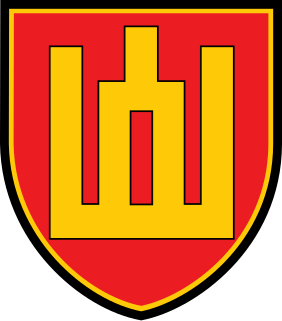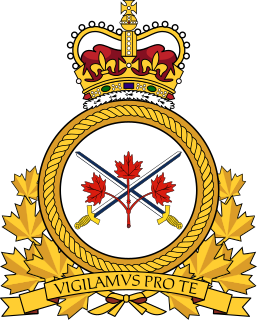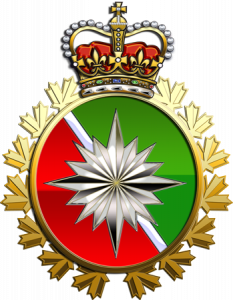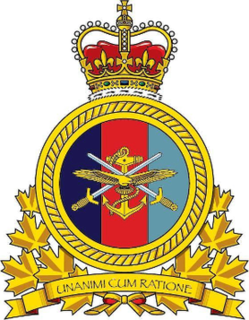
The Lithuanian Armed Forces consist of 20,565 active personnel. Conscription was ended in September 2008 but reintroduced in 2015 because of concerns about the geopolitical environment in light of Russia's military intervention in Ukraine.

The Canadian Armed Forces, or Canadian Forces, are the unified armed forces of Canada, as constituted by the National Defence Act, which states: "The Canadian Forces are the armed forces of Her Majesty raised by Canada and consist of one Service called the Canadian Armed Forces."

The Canadian Army is the command responsible for the operational readiness of the conventional ground forces of the Canadian Armed Forces. As of 2018 the Army has 23,000 regular soldiers, about 17,000 reserve soldiers, including 5,000 rangers, for a total of 40,000 soldiers. The Army is also supported by 3,000 civilian employees from the civil service. It maintains regular forces units at bases across Canada, and is also responsible for the Army Reserve, the largest component of the Primary Reserve. The Commander of the Canadian Army and Chief of the Army Staff is Lieutenant-General Wayne Eyre.

Supreme Headquarters Allied Powers Europe (SHAPE) is the headquarters of the North Atlantic Treaty Organization's Allied Command Operations (ACO). Since 1967 it has been located in Casteau, north of the Belgian city of Mons, but it had previously been located, from 1953, at Rocquencourt, next to Versailles, France. From 1951 to 2003, SHAPE was the headquarters of Allied Command Europe (ACE). Since 2003 it has been the headquarters of Allied Command Operations, controlling all NATO operations worldwide.

Operation Noble Eagle (ONE) is the United States and Canadian military operation related to homeland security and support to federal, state, and local agencies. The operation began 14 September 2001, in response to the September 11 attacks.

Joint Task Force 2 (JTF2) is a special operations force of the Canadian Armed Forces. Regarded as the "Jewel in the Crown" of the Canadian Special Operations Forces Command, JTF2 is currently based at Dwyer Hill, near Ottawa, Ontario.

Chemical, biological, radiological and nuclear defense are protective measures taken in situations in which chemical, biological, radiological or nuclear warfare hazards may be present. CBRN defense consists of CBRN passive protection, contamination avoidance and CBRN mitigation.
The Disaster Assistance Response Team (DART) is a rapidly deployable team of 200 Canadian Forces personnel. It provides assistance to disaster-affected regions for up to 40 days. DART's headquarters is located in Kingston, Ontario. DART was created by the Canadian government in 1996 in the aftermath of the inadequate response to the 1994 Rwandan genocide, when Canada's aid arrived after the peak of a cholera epidemic. The government determined that it would be of the utmost importance in many disasters if it was able to rapidly deploy a group of people until long-term aid arrived. DART has an annual budget of CA$500,000, although during specific incidents the Parliament of Canada can choose to temporarily allocate millions of dollars to DART to fund their response effort. For example, Operation Torrent, the aid mission to Turkey in the wake of the 1999 earthquake which left 17,000 people dead, saw CA$15 million used by DART in the response.

The Canadian Forces Military Police provide police, security and operational support services to the Canadian Armed Forces (CF) and the Department of National Defence (DND) worldwide.
The Armed Forces Council is the senior military body of the Canadian Armed Forces. It meets to advise and assist the Chief of the Defence Staff (CDS) on all matters concerning the command, control, and administration of the forces, and generally meets once per month.

The Intelligence Branch is a personnel branch of the Canadian Forces (CF) that is concerned with providing relevant and correct information to enable commanders to make decisions.

Canadian Special Operations Forces Command is a command of the Canadian Armed Forces. It is responsible for all special forces operations that are capable of responding to terrorism and threats to Canadians and Canadian interests around the world.

The Canadian Special Operations Regiment is an elite unit of the Canadian Armed Forces. It forms part of the Canadian Special Operations Forces Command. As a special forces unit, the regiment's roles include conducting complex or difficult raids, capturing strategic facilities and undertaking reconnaissance. It is also capable of working with the armed forces of other countries.

The Primary Reserve of the Canadian Armed Forces is the first and largest of the four sub-components of the Canadian Forces reserves, followed by the Supplementary Reserve, the Canadian Rangers, and the Cadet Organizations Administration and Training Service.

Operation Mobile was the name given to Canadian Forces activities in the 2011 military intervention in Libya. The United States' counterpart to this was Operation Odyssey Dawn, the French counterpart was Opération Harmattan and the British counterpart was Operation Ellamy. The no-fly zone was proposed during the Libyan Civil War to prevent government forces loyal to Muammar Gaddafi from carrying out air attacks on anti-Gaddafi forces and civilians. The demonstrations in Libya were part of the larger Arab Spring movement that began in the country of Tunisia on 18 December 2010. When demonstrations began in Libya, the government of Muammar Gaddafi responded with systematic attacks by air and ground forces, and repression of the protesters. In a speech, Gaddafi promised to chase down the protesters and cleanse the country "house by house". Several countries prepared to take immediate military action at a conference in Paris on 19 March.

The Canadian Joint Operations Command is one of the two unified commands of the Canadian Armed Forces, the other one being the Canadian Special Operations Forces Command. CJOC was announced in May 2012 as the result of the cost-cutting measures in the 2012 federal budget through the merger of Canada Command, the Canadian Expeditionary Force Command and the Canadian Operational Support Command under an integrated command-and-control structure. The command was stood up on 5 October 2012 to officially replace the three former organizations.

An air force is in the broadest sense, the national military branch that primarily conducts aerial warfare. More specifically, it is the branch of a nation's armed services that is responsible for aerial warfare as distinct from an army or navy. Typically, air forces are responsible for gaining control of the air, carrying out strategic and tactical bombing missions, and providing support to land and naval forces often in the form of aerial reconnaissance and close air support.
This articles outlines the defence forces of the European Union (EU), which implement the EU's Common Security and Defence Policy (CSDP) in CSDP missions. There are two categories of EU multinational forces: ones that have been established intergovernmentally and made available to the CSDP through article 42.3 of the Treaty on European Union (TEU), such as the Eurocorps; and the EU Battlegroups, established at the EU level.














